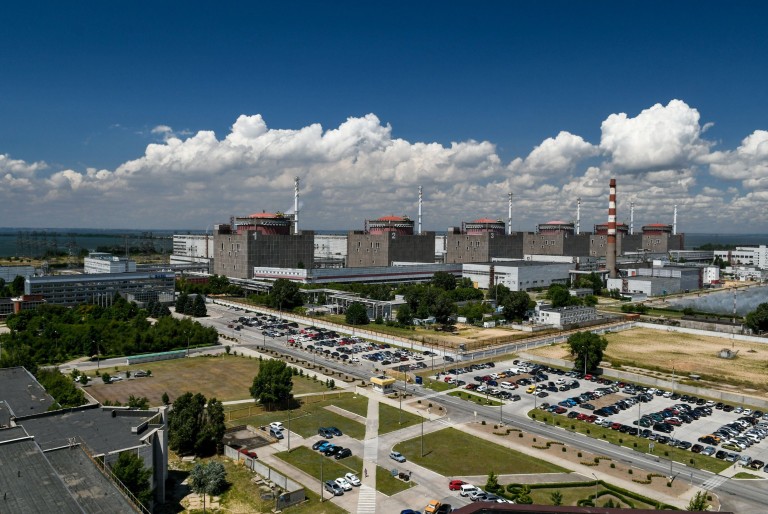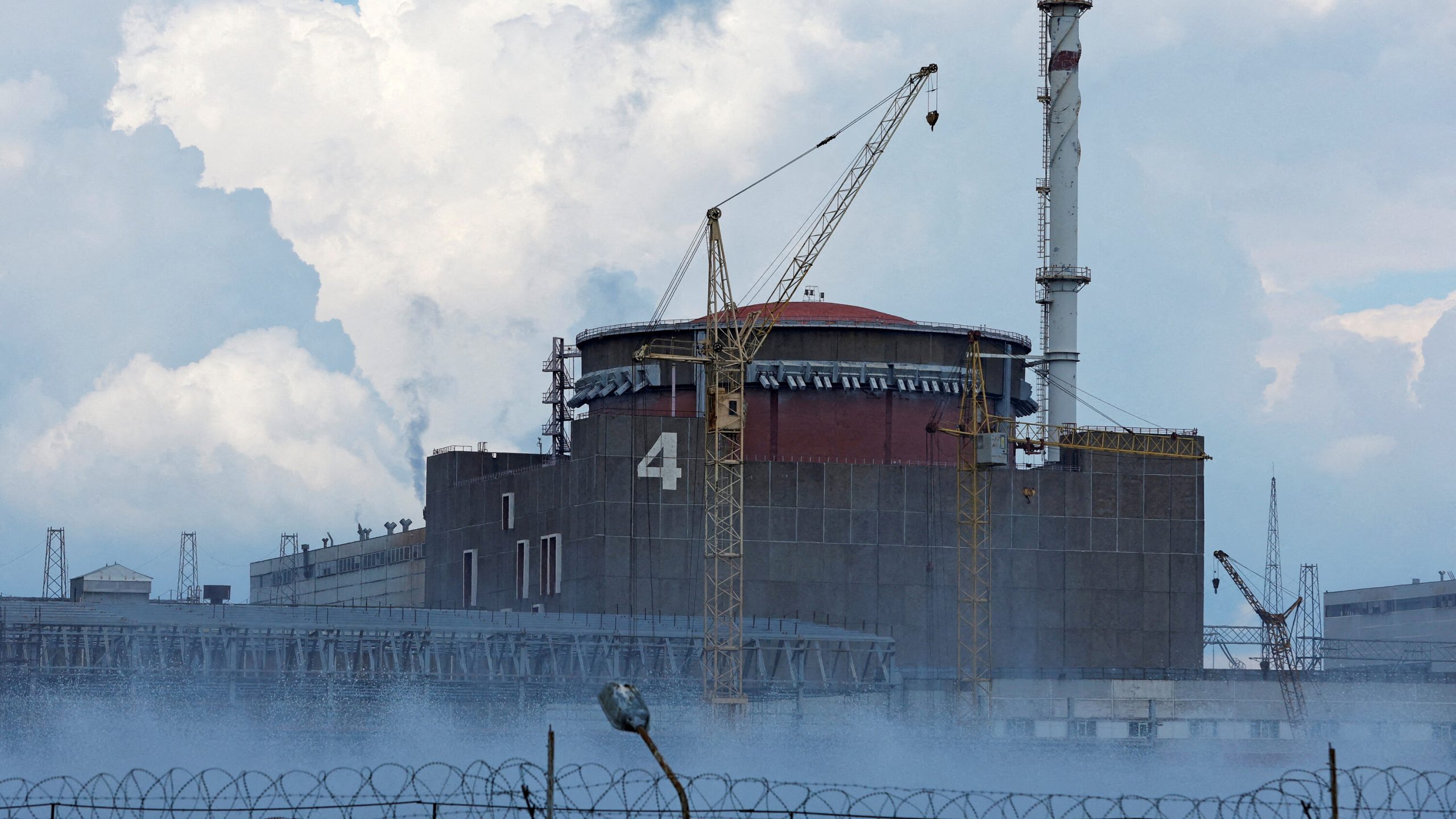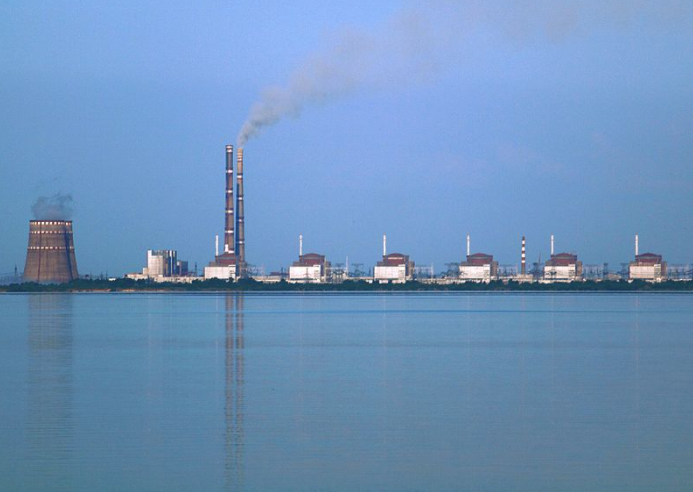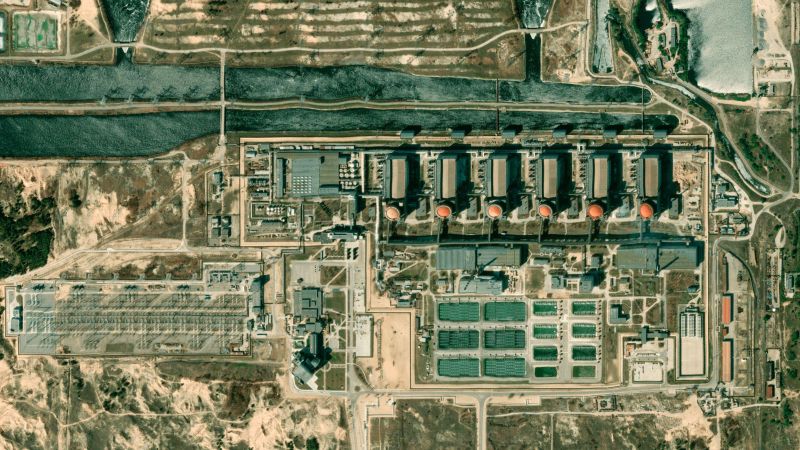
The Zaporizhzhia region in south eastern Ukraine houses the largest nuclear power station in Europe – the Zaporizhzhia NPP – one of the ten largest such plants in the world. It is currently in an intensely fought war zone. Dr Philip Webber, SGR, explains some of the risks of radiation releases that this poses, both nationally and internationally.
About the Zaporizhzhia site
The Zaporizhzhia nuclear plant [1] is part of a huge industrial complex some 8km square.
It houses six large (1 gigawatt or GW) VVER-1000 Russian designed and built nuclear power reactors, [2] three thermal (coal- and gas-powered) power stations, and the purpose-built city of Enerhodar, which was built in 1970 to house 11,000 power plant workers and a total population of around 53,000. [3]
Before the war, the nuclear plant supplied about 20% of Ukraine’s electricity – widely used for heating in large apartment blocks. The reactors’ containment structures [4] house the nuclear core and used or ‘spent’ nuclear fuel in cooling pools.
After five years, this spent fuel is transferred to dry storage casks nearby, which are air-cooled. In addition, huge external cooling ponds – which are continuously sprayed with water – store many older used nuclear fuel rods. The three thermal plants were shut down in May 2022 having run out of fuel due to the Russian invasion.
The Zaporizhzhia power site is much larger than the biggest UK nuclear sites such as Sellafield or Hinkley Point – either of these would fit within just the area of the cooling ponds at Zaporizhzhia.
The entire complex is situated on a flat promontory on the south-east bank of the Dnipro River which is 5km wide at that point. [5] The site is 50km south west of the city of Zaporizhzhia, also on the south bank of the Dnipro. Kherson is about 150km to the south west – but on the other bank of the river.
Under occupation
The reactor site has been occupied by Russian military forces since March 2022 – with Ukrainian forces in control of the opposite river bank. The original Ukrainian Energoatom plant operators are being forced to keep working there under conditions of extreme stress.
These stresses include excessively long shifts, extreme concerns about family safety, and even the arrest of the plant chief. Various parts of the site have been hit by artillery shells and warheads from rocket-launched missiles over several months.
Photographs show cratering and rocket tubes embedded in the ground. Both sides accuse the other of deliberately targeting and hitting the plant site. As a result of major safety concerns, the International Atomic Energy Agency (IAEA) has placed monitoring teams at the site and nearby, but sourcing reliable information remains extremely difficult. [6]
The local electricity grid is very extensive and extremely vulnerable. Before the war, several high voltage (HV) power lines extended east from the nuclear and thermal plants to what is now Russian-occupied Ukraine via extensive electricity sub-stations, whilst one large HV line connected directly across the Dnipro to the opposite bank – under the control of Ukraine – via Marhanets just 15km away.
Artillery shells can easily be fired over 40km whilst rocket launchers can reach even further, so the entire area is within range of both Russian and Ukrainian forces. Perhaps unsurprisingly, the IAEA continue to report that connections to the electricity grid keep being destroyed by artillery shelling which are then intermittently repaired.
Repairs are very difficult owing to a severe shortage of supplies such as power transformers, insulators, cabling and HV circuit breakers. So far, neither the containment buildings for the reactors, nor the spent fuel assemblies in canisters, nor the large cooling ponds appear to have been seriously breached, but there is no guarantee this will continue to be the case.
The plants remain in a highly contested conflict area. The IAEA and UN have called for the plants to be placed in a demilitarised safety zone. No such zone has yet been set up. It is perhaps worth saying that any such demilitarised zone would have to include the city of Enerhodar because of its intimate connection and proximity to the nuclear power plants and power lines that traverse the entire area.
Creating such an exclusion zone at the centre of a high intensity war zone is extremely difficult and has been rarely achieved in other conflicts.

Emergency shutdown
It is extremely difficult to secure a reliable picture of what is actually going on at the Zaporizhzhia power generation site. The most reliable and consistent reporting in December 2022 appears to be that all of the Zaporizhzhia reactors were ‘scrammed’ – put into emergency shutdown – as the entire Ukrainian power grid was hit by multiple Russian strikes on 23rd November 2022.
All of Ukraine’s other three reactor sites – Rivne, South Ukraine and Kmelnytskyi – were also scrammed. These three latter plants are still under Ukrainian control being outside of the Russian occupied areas east of the Dnipro River. In a scram, the control rods are fully inserted into the reactor, emergency back-up diesel generators are activated for core cooling, and thus the reactor cores gradually reduce to low levels of nuclear fission.
According the Petro Kotin, President of Energoatom, [7] after the emergency shutdowns, two of the six Zaporizhzhia reactors were restarted to generate sufficient power to enable the emergency diesel generators to be taken off-line and to provide some power to the city of Enerhodar.
However, restarting a cold shutdown reactor is very far from routine in the middle of a war zone without reliable external power supplies. Emergency shutdowns and restarts place large strains on the steam generation circuit pipework and valves making equipment failures more likely.
What if the cooling fails?
Any nuclear reactor, for safe operation, needs to be connected to an electricity supply to provide a reliable source of emergency core cooling power. Without such active cooling from pumped water, the reactor core will eventually overheat to dangerous levels. Outside the reactor cores, radioactive decay in spent fuel continues, releasing heat inside the reactor containment structure, the dry storage casks, and the external ponds.
Any failures of, or threats to, electricity supplies create serious emergency situations. Because of this danger, each reactor has emergency diesel-fired electricity generators with around 10 days of fuel. [8]
Ultimately, without active cooling powered by the grid, and once back-up diesel generators run out of fuel, core temperatures would rise uncontrollably. This would lead first to hydrogen gas release, then explosions, and ultimately, runaway core meltdowns breaching the core containment.
This is what happened at the Fukushima nuclear plant in Japan in 2011 [9] – when the cores in three reactors could not be cooled, large volumes of hydrogen gas were released into the containment structures, which then exploded, releasing highly radioactive materials into the environment – mainly as gases and vapours.
After a few days, the reactor cores reached the melting points of the nuclear fuels and these highly radioactive molten materials burned down through the lower regions of the reactor vessels. This situation also has similarities with the 1986 Chernobyl disaster – the site of which is now part of Ukraine (and was occupied briefly by Russian troops early during the invasion).
In a reactor core of 1GW size, as those at Zaporizhzhia, if the cooling system breaks down, hydrogen explosions would occur after 8 to 12 hours. After about two days, the reactor core would become hot enough to burn through the base of the reactor vessel. [10]
Cooling for the reactor cores and spent fuel storage relies on several factors: a reliable supply of water; a reliable supply of power for the cooling pumps; working pumps; and staff to conduct any repairs and maintain the cooling systems.
Without a reliable connection to the electricity grid, the only source of power for the pumps are, as mentioned, the back-up generators. With all of these factors now under threat, the risk of a reactor containment breach due to cooling failure is high. [11]
Other risks result from the ongoing conflict. Whilst an artillery shell or conventional cruise missile strike is unlikely to breach the reactor core containment directly, the threat is much greater to the integrity of over 3,000 spent fuel assemblies stored locally in concrete containers.
Artillery, or a cruise missile could easily breach any of these containers releasing highly radioactive materials. This in turn could make part of the site – for example, cooling circuitry or fuel supplies – too dangerous to manage, which would lead to an even more serious core failure.

The possible effects of a nuclear disaster
There are a wide range of possible disaster scenarios.
Firstly, considering a meltdown of one or more reactor cores, the most comparable reactor accident so far has been the Fukushima plant radiation releases following the Great East Japan Earthquake and its subsequent tsunami in 2011.
This led to an initial obligatory exclusion zone of 20km radius around the plant with 30km radius stay-at-home and no-fly zones and finally a larger zone extending 40km to the north west.
Within a year, some people were permitted to return home within the 20km zone, whilst others with higher radiation levels were restricted for five years after the disaster, and a 30-year clean up period was envisaged.
The Fukushima experience however does not give one high confidence that future nuclear disasters may be better managed. Following the meltdowns, the Japanese authorities did not coordinate information about radiation properly.
For example, residents were evacuated from one area to another which in fact had higher levels of radiation contamination. [12] There were multiple failures including a lack of evacuation planning and deliberate restriction of information.
Establishing the levels of radiation requires monitoring over-flights – in the Fukushima case, these were undertaken by the US military.
Such flights would be highly dangerous and perhaps impossible in a war zone, so it would be extremely difficult for anyone to gather accurate information about the radiation levels on the ground. This would make any emergency planning very difficult from the outset.
A further difficulty arising from the conflict is that emergency responses such as evacuation of population, distribution of iodine tablets or provision of emergency medical treatment would be very difficult to coordinate, especially as no one authority would be able to take charge of the situation.
Reactor crises require rapid, coordinated and well-organised recovery measures including evacuation, emergency measures to reduce radiation, suppress fires etc. These would be unlikely to be possible further increasing the impacts of any radiation release.
The most likely risk scenario is a breach of spent fuel held in canisters or cooling ponds outside of the reactor core containment structure. This spent fuel is still highly radioactive and vulnerable to missiles, shells and rocket strikes which could spread radiation directly or start fires spreading radiation.
An impact by an aircraft is also a significant risk due to the highly inflammable aircraft fuel onboard.

What if a nuclear weapon were used?
At Zaporizhzhia, the large amounts of spent fuel storage make this risk even worse. Fallout would create a lethal radiation risk across the entire plant site and city of Enerhodar.
Risks downwind would be highly dependent on the wind direction, speed and any rainfall, but could threaten lethal dose rates in Marhanets and Nikopol (population 100,000) only 15km away. Lethal radiation doses could be experienced at least 60km downwind. [14]
This could potentially include the city of Zaporizhzhia itself, which had a pre-war population of 750,000. This would present a completely unmanageable evacuation requirement in peacetime let alone in the middle of an intense war.
Depending on the dose rates, some areas may need to be avoided for years to decades. This was a major problem after the Chernobyl nuclear disaster of 1986 with a 30km radius exclusion zone still in place over 30 years later.
In the case of a larger nuclear weapon (e.g. 1,000kT), even larger potentially lethal radiation zones would be created up to 550km in extent and 100km wide. [15] Again, the primary source of radiation risk would be the reactor products, although in this case, combined with major blast and fire damage across a 5km radius.
Impacts in a war zone
Both the risk of a nuclear disaster and the consequences of it are multiplied in a war zone. In Ukraine, the population are already suffering intense pressure, strain and casualties due to direct impacts such as widespread Russian bombardment with artillery and missiles.
Continued attacks on the energy infrastructure are leading to widespread power outages, water shortages, cold homes and huge damage to vital infrastructure such as hospitals and access to medical care.
These acts already amount to widespread breaches of international humanitarian law, and are contributing to an as yet uncertain death toll amongst the civilian population.
Any nuclear accident leading to a significant release of radiation would further escalate consequences by adding yet another layer of uncertainty and danger combined with extreme difficulty in responding to an emergency.
Coordination of effort cannot be achieved in the middle of an intense conflict; within Ukraine, comprehensive radiation monitoring would be extremely difficult or impossible and either side would doubt any information that was produced.
Any of the more severe accident scenarios could result in radiation impacts outside of the borders of Ukraine including the EU, Russia and Belarus. In the case of Chernobyl these led to restrictions on some food stuffs over very wide areas.
The only conclusion that can be drawn is that the existence of nuclear plants in any war zone creates a whole new range of risks and dangers as the maintenance of safe operation relies on expert management, reliable supplies of vital materials such as diesel, and a connection to a working grid.
Nuclear power and conflict (or environmental disaster such as recent flooding in Pakistan or drought in France) are mutually incompatible. For this reason, some commentators have likened nuclear reactors to giant landmines that can be ‘detonated’ in war in a disaster impossible to contain or effectively manage.
The other three Ukraine reactor sites are also at high risk due to damage to the electricity grid and have already been subject to emergency shutdown due to such damage.
The attacks on the electricity supplies also create problems and risks for neighbouring Moldova which also faces a cold winter as it obtains its electrical power from the Ukrainian grid via Russian-controlled Transnistria. [16]
Any conflict highlights how our modern society now relies on a wide range of infrastructure: energy; clean water; medical and social care; and other public services such as housing and transport.
Wars disrupt all of these as they become deliberate military targets in the attempt to disrupt the resources that support frontline troops and to break the resolve of the civilian population. This has been the case for centuries and continues regrettably with much more destructive weaponry today. [17]
Other recent examples of the targeting of civilians and vital infrastructure include conflicts in former Yugoslavia, Iraq, Afghanistan, Syria, Yemen and several ongoing conflicts across the horn of Africa.
That today, in Europe, yet another conflict is seeing deliberate attacks on civilian targets including highly vulnerable nuclear power plants, water supplies and the electricity grid is yet another example of how vital it is to find peaceful solutions to conflict and how ultimately military action creates long-lasting destruction that will take decades of post-conflict rebuilding and many generations to heal.
Dr Philip Webber is Chair of Scientists for Global Responsibility. He has written widely on the risks of nuclear weapons and nuclear power – including co-authoring the book London After the Bomb. He spent part of his career working as an emergency planner in local government.
Originally published by Responsible Science Journal
Republished by The 21st Century
The views expressed in this article are solely those of the author and do not necessarily reflect the opinions of 21cir.com.
Notes
[1] Wikipedia (2022a). https://en.wikipedia.org/wiki/Zaporizhzhia_Nuclear_Power_Plant
[2] The VVR reactors are not only Russian designed and built but also supplied with enriched uranium from Russia. Despite much publicised sanctions, 20% of the nuclear fuel used by the EU is still supplied by Russia. No2NuclearPower (2022). 2 December. https://www.no2nuclearpower.org.uk/news/nuclear-fuel-3-12-22/
[3] Wikipedia (2022b). https://en.wikipedia.org/wiki/Enerhodar
[4] A reactor containment structure is a massive concrete and steel structure designed to contain intense radiation and superheated steam circuit pipework and valves protecting the highly radioactive reactor core.
[5] The river is dammed in several places, so strictly speaking the body of water to the north of Zaporizhzhia is part of the extensive Kakhovka reservoir 240km long and up to 23km wide.
[6] IAEA (2022). Director General Statement on Situation in Ukraine, 20 November. https://www.iaea.org/newscenter/pressreleases/update-128-iaea-director-general-statement-on-situation-in-ukraine
[7] The Observer (2022). 27 November. https://www.theguardian.com/world/2022/nov/26/fears-for-all-ukraines-nuclear-plants-after-emergency-shutdowns
[8] Electricity Info (2022). 9 October. https://electricityinfo.org/news/ukraine-zaporizhzhia/
[9] Wikipedia (2022c). https://en.wikipedia.org/wiki/Fukushima_nuclear_disaster
[10] Wikipedia (2022d). https://en.wikipedia.org/wiki/Nuclear_meltdown (also see note 13)
[11] Popovych Z, Bondar D, Ramana M (2022). 7 October. https://thebulletin.org/2022/10/zaporizhzhia-on-the-brink-how-deteriorating-conditions-at-the-nuclear-power-plant-could-lead-to-disaster/; Ouest France (2022). 1 September. https://www.ouest-france.fr/monde/guerre-en-ukraine/guerre-en-ukraine-quels-sont-les-risques-d-accident-nucleaire-autour-de-la-centrale-de-zaporijjia-b1108af8-29e8-11ed-bd3f-f86da3bd80f7
[12] Reference 133: The Economist, 10 March 2012 from: Wikipedia (2022c) – as note 9.
[13] Fetter S, Tsipis K (1981). Catastrophic Releases of Radioactivity. Scientific American, vol.244, no.4, pp.41–47; Rotblat J (1981). Nuclear radiation in warfare. SIPRI/ Taylor & Francis; Fetter S (1982). The Vulnerability of Nuclear Reactors to Attack by Nuclear Weapons. Massachusetts Institute of Technology, Program in Science and Technology for International Security, Report No.7.
[14] This estimate is based on fallout spread for a 1kT weapon from nuclear tests entraining reactor products. Data from: Fetter (1982); Rotblat (1981) – as note 13.
[15] The danger zone (1 gray cumulative dose causing radiation sickness and some longer-term deaths) for a 1GW reactor and 1MT weapon is 550km x 100km. Rotblat (1981) – as note 13.
[16] In a legacy from the Soviet Union, the Ukraine, Russian and Moldovan electrical power grids remain part of a common infrastructure. Quite apart from efforts by the EU to secure energy independence from Russia and self-sufficiency this is another example of how interdependence of energy supplies can be used as a weapon of war.
[17] Some weapons have been specifically designed to damage electricity generation for example by air-dropped conducting fibres.
